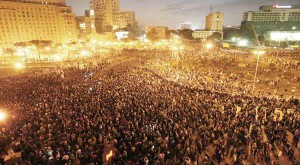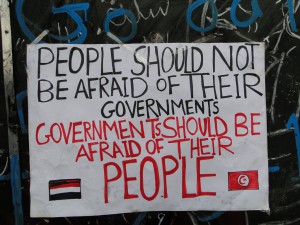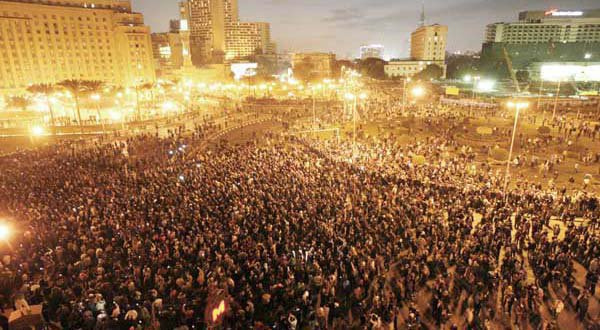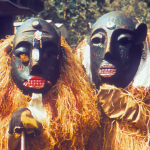A few years ago, no one would have imagined that Salam City, a poor suburb in the periphery of Cairo, could become the heart of a music scene that would come to influence the whole of Egypt. The town, which was erected after a 1992 earthquake, now houses artists that, although hardly known outside of Egypt, have succeeded in establishing a new musical genre that is played all over Cairo and is slowly spreading to other parts of Egypt. This new genre, which is called Mahraganat- “festival” in Arabic, combines heavily audiotuned lyrics written in the local slang with traditional Egypt shaabi music and influences from hip-hop and electronic music and hit the scene in 2009, just a year before the revolution began.
Mahraganat, also known as electro shaabi, can be understood as music created by the poor for the poor. Its listeners are mostly young working class people with low prospects for the future and the quality of music is not very high, since the technical possibilities are quite restricted due to a lack of funding. It started off on a local level, with online video platforms, like Youtube, being one of the primary ways of distribution. Artists would sing about the life in their neighbourhood, which made them quite popular with the people living there. Although Mahraganat has grown, spread and evolved over the years, it still retains its focus on the artists’ respective neighbourhoods and remains the music of the streets.
In the turmoil of the demonstrations that would lead to the overthrow of Hosni Mubarak’s government and the ensuing chaos, it was easier for the artists to promote their music by giving concerts in spaces formerly reserved for bigger artists as there was nobody to hinder them from doing so. In a way, the Arab Spring paved the way for this anti-traditional kind of music.
as there was nobody to hinder them from doing so. In a way, the Arab Spring paved the way for this anti-traditional kind of music.
It is also the Arab Spring that provided the main incentive for an evolution of the genre. With thousands occupying Tahrir Square in Cairo from January 2011 onward, it was inevitable for the artists and their music to be politicised. Their focus had shifted toward political expression and nowadays, the music also tackles social issues like the ever present sexual harassment of women in Egypt, drugs and violence, breaking with the taboo issues in Egypt’s traditional society. Other than most other genres, Mahraganat music dares to speak up openly, which is why it is considered too vulgar to be played on public radio stations and is viewed with contempt by most middle- and upper-class people.
The most famous amongst the Mahraganat artists, Sadat, is often credited with being the first musician of the genre, has become a hero of the young people of Salam City. He is a former aluminium factory worker who was able to overcome problems, like his social status, and is now a successful musician known all over Egypt, for example, his wedding party was attended by about 20,000 people. Sadat also inspires others to do as he has and despite his success, he stays true to his neighbourhood of Salam City where he continues to live and perform free concerts. Just like other artists, he still relies on performances as a primary source of income, as the Mahraganat scene is mainly directed via genre websites that provide the music for free.
Mahraganat, however, is not an isolated case. Various other music genres have emerged in the past few years in the Islamic world. Slowly, traditional Islamic society is opening up for what can be called a Westernisation of music. Muslim punk, also called Taqwacore, was popularised following the publishing of Michael Knight’s novel The Taqwacores in 2003. Taqwacore, although still tightly bonded to Islam, takes a more radical approach to religious themes than Mahraganat, which is also why religious authorities are feeling challenged by the ideas of Taqwacore. The scene witnessed a major crackdown in 2012, when Indonesian police forcibly shaved the heads of concert-goers in an effort to “rehabilitate” them into Indonesia’s predominantly Muslim society.
But not all of the new genres are critical of Islam. Muslim hip-hop, which developed during the 1990s, spawned a new sub-genre called “jihadi rap” following the events of 9/11 and the wars in Afganistan and Iraq. Artists of this genre rally against the USA and its allies, promote self-sacrifice  and seek to inspire young Muslims to join the Jihadist movements. The USA quickly became aware of this and launched campaigns using hip-hop as a means of cultural understanding, with rap artists touring the Islamic world, like the national ping-pong team did in China back in the times of ping-pong diplomacy.
and seek to inspire young Muslims to join the Jihadist movements. The USA quickly became aware of this and launched campaigns using hip-hop as a means of cultural understanding, with rap artists touring the Islamic world, like the national ping-pong team did in China back in the times of ping-pong diplomacy.
Following the politicisation of the music and media coverage on the Arab Spring, Mahraganat also became known outside of Egypt with various artists of the genre enabled to perform abroad. A circumstance which also inspired cooperation with the London-based urban music radio station Rinse FM, which tries to support Mahraganat music by giving artists opportunities to collaborate with UK electronic music artists and to learn not only about technical subjects such as mastering, but also about how they can sell their music better in order to expand. Sadat is one of them.
By Michael Schätzlein
Image Credit:
Picture 1: Ron Rothbart, licensed under CC BY 2.0
Picture 2: Ramy Raoof, licensed under CC BY 2.0










